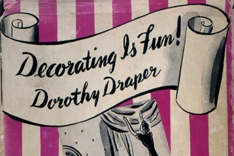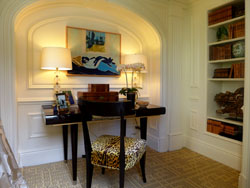How to Dress Up Your Walls - Part II
 Alexia Rossetti
Alexia Rossetti  Thursday, August 29, 2013 at 11:00AM
Thursday, August 29, 2013 at 11:00AM  Cinque Terre from the Thief and the Knight / The Amalfi Coast by Camrio / Sailing in South of France by Osinni - from Brunelli Designs Inc.
Cinque Terre from the Thief and the Knight / The Amalfi Coast by Camrio / Sailing in South of France by Osinni - from Brunelli Designs Inc.
Dressing up your room's walls is a crucial part of interior design; it provides a focal point for all those who enter the room. In a previous blog, I mentioned creating themes as a jumping off point for dressing up your walls. An easy theme to use is travel. But travel could encompass a wide selection of work so it’s best to narrow it down even further. If your client, for instance, loved travel and the ocean; then choose artwork with both these themes, creating a strong cohesive group of artwork.
In our example above, we chose art work showing off Cinque Terre and the Amalfi Coast of Italy, and also from the South of France. Notice how the blues and greens of the pictures bring the grouping together. Below is a grouping of various landscapes. Besides choosing a common theme, you should also choose artwork with the same intensity of colors. A bold picture with saturated colors may overwhelm a more delicate picture of pastels.
 Clockwise from top left: Champ d’avoine by Monet / Russian Winter by Barasch, High Sierra by C. Bruder – both from Brunelli Designs Inc. / Path to Crescent Bay, Laguna Beach – by Charles Zoltan - from Stewart Fine Art
Clockwise from top left: Champ d’avoine by Monet / Russian Winter by Barasch, High Sierra by C. Bruder – both from Brunelli Designs Inc. / Path to Crescent Bay, Laguna Beach – by Charles Zoltan - from Stewart Fine Art
Another way to choose a group of artwork is to stick to a similar style of painting. Above you have artwork with a realistic approach to the landscapes; below shows a more abstracted brushwork. The artwork below is a series of watercolors by Lisbeth Reed.
 Clockwise from top: Dirt Road, Hidden Cupola, Seaside Landscape – all by Lisbeth "Bet" Reed – from Wallbangers
Clockwise from top: Dirt Road, Hidden Cupola, Seaside Landscape – all by Lisbeth "Bet" Reed – from Wallbangers
Interested in learning more about accessorizing? Take a look at New York Institute of Art and Design. At NYIAD, you will learn how to transform a space, create color schemes, and select furniture, lighting, and accessories.
 displaying artwork in
displaying artwork in  Interior Design/Decorate
Interior Design/Decorate 



